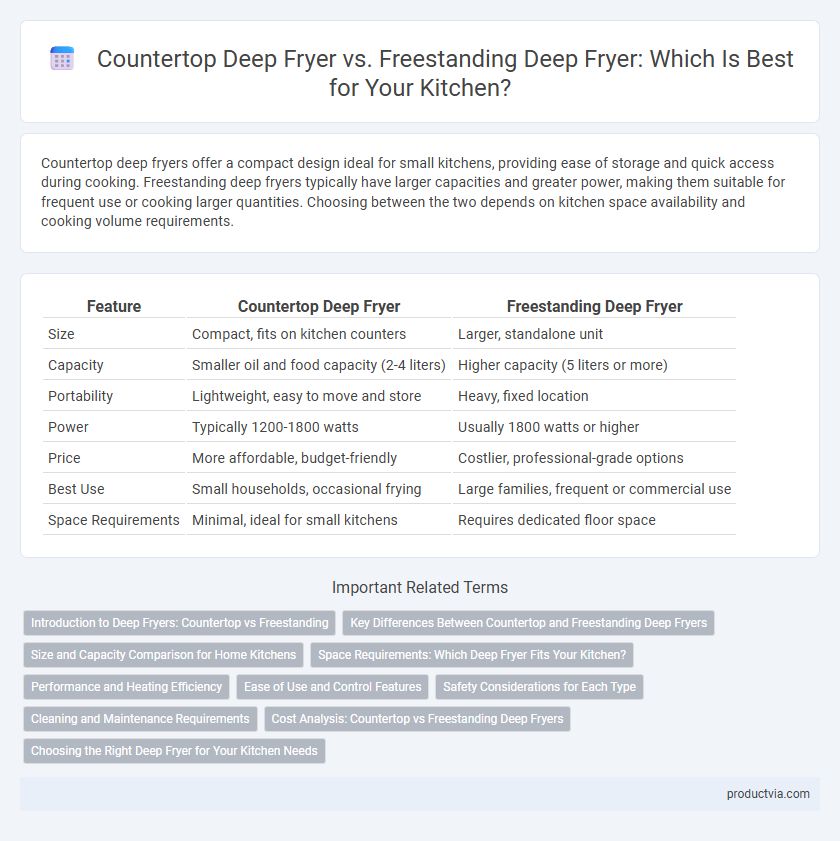Countertop deep fryers offer a compact design ideal for small kitchens, providing ease of storage and quick access during cooking. Freestanding deep fryers typically have larger capacities and greater power, making them suitable for frequent use or cooking larger quantities. Choosing between the two depends on kitchen space availability and cooking volume requirements.
Table of Comparison
| Feature | Countertop Deep Fryer | Freestanding Deep Fryer |
|---|---|---|
| Size | Compact, fits on kitchen counters | Larger, standalone unit |
| Capacity | Smaller oil and food capacity (2-4 liters) | Higher capacity (5 liters or more) |
| Portability | Lightweight, easy to move and store | Heavy, fixed location |
| Power | Typically 1200-1800 watts | Usually 1800 watts or higher |
| Price | More affordable, budget-friendly | Costlier, professional-grade options |
| Best Use | Small households, occasional frying | Large families, frequent or commercial use |
| Space Requirements | Minimal, ideal for small kitchens | Requires dedicated floor space |
Introduction to Deep Fryers: Countertop vs Freestanding
Countertop deep fryers offer compact design and portability, making them ideal for small kitchens and occasional frying needs. Freestanding deep fryers provide larger capacity and enhanced power, suitable for high-volume frying in commercial or spacious home kitchens. Choosing between the two depends on space availability, cooking frequency, and desired output volume.
Key Differences Between Countertop and Freestanding Deep Fryers
Countertop deep fryers offer compact size and portability, making them ideal for small kitchens or limited counter space, while freestanding deep fryers provide larger capacity and more powerful heating elements suitable for commercial or high-volume cooking. Countertop models generally feature simpler controls and easier storage options, whereas freestanding units often include advanced temperature regulation and multiple frying baskets for simultaneous cooking. Energy consumption varies, with freestanding deep fryers typically using more power but delivering faster cooking times and consistent heat distribution.
Size and Capacity Comparison for Home Kitchens
Countertop deep fryers typically offer a more compact size with capacities ranging from 1 to 4 liters, making them ideal for small to medium home kitchens where space is limited. Freestanding deep fryers generally feature larger tanks exceeding 5 liters, providing higher cooking volumes suited for bigger households or frequent frying needs. Choosing between the two depends on balancing kitchen space constraints with desired frying capacity for optimal convenience and efficiency.
Space Requirements: Which Deep Fryer Fits Your Kitchen?
Countertop deep fryers are compact and ideal for kitchens with limited space, offering easy storage and portability. Freestanding deep fryers require a dedicated area, demanding more floor space but often providing larger oil capacity and higher cooking power. Choosing between them depends on kitchen size, available counter or floor space, and cooking volume needs.
Performance and Heating Efficiency
Countertop deep fryers deliver rapid heating and precise temperature control due to their compact design and insulated heating elements, leading to consistent frying results and reduced energy consumption. Freestanding deep fryers, equipped with larger oil capacities and more powerful heaters, excel in handling high-volume cooking but may require longer preheating times and can be less energy-efficient. Performance efficiency hinges on kitchen space, usage frequency, and frying volume, with countertop models best suited for small-scale or occasional use, while freestanding models provide superior capacity and durability for commercial or heavy-duty kitchens.
Ease of Use and Control Features
Countertop deep fryers offer compact designs with intuitive controls, making them ideal for kitchens with limited space and users seeking straightforward operation. Freestanding deep fryers feature advanced temperature settings and larger oil capacities, providing enhanced control for high-volume cooking environments. Choosing between the two depends on the balance between space constraints and the need for precise cooking adjustments.
Safety Considerations for Each Type
Countertop deep fryers offer enhanced safety features such as automatic shut-off systems and cool-touch exteriors, reducing the risk of burns and accidental fires in compact kitchen spaces. Freestanding deep fryers, while larger and capable of higher oil capacity, require more careful placement to prevent tipping hazards and typically need dedicated ventilation to manage heat and smoke safely. Choosing between the two depends on kitchen size, user experience, and the importance of built-in safety mechanisms like non-slip feet and temperature controls.
Cleaning and Maintenance Requirements
Countertop deep fryers typically feature compact designs and removable oil tanks, making cleaning and maintenance more straightforward and faster compared to freestanding models. Freestanding deep fryers often have larger capacities and integrated filtration systems, but their size and fixed installation can complicate oil disposal and thorough cleaning. Regular maintenance of heating elements and oil filters is essential in both types to ensure optimal performance and extend appliance lifespan.
Cost Analysis: Countertop vs Freestanding Deep Fryers
Countertop deep fryers typically range from $50 to $150, offering an affordable option suitable for small kitchens and occasional use. Freestanding deep fryers, priced between $200 and $500, provide higher capacity and more advanced features tailored for commercial or heavy-duty cooking. Evaluating cost against kitchen space and cooking volume helps determine the most efficient investment in deep frying equipment.
Choosing the Right Deep Fryer for Your Kitchen Needs
Countertop deep fryers offer compact designs ideal for small kitchens or limited counter space, providing quick heating and easy storage, while freestanding deep fryers deliver larger capacities suitable for high-volume cooking in commercial or spacious home kitchens. Consider factors such as available space, cooking capacity, and ease of cleaning when selecting between countertop and freestanding models to ensure the appliance meets your cooking frequency and volume demands. Efficiency in oil heating and temperature control features also play crucial roles in optimizing frying performance tailored to your kitchen workflow.
Countertop deep fryer vs freestanding deep fryer for kitchen Infographic

 productvia.com
productvia.com